Art is an important feature for many masonic lodges, whether this is an oil painting or unique item which can aid the continuation of masonic studies, advancement ceremonies and rituals throughout the world. Masonic tracing boards are one of the most significant pieces of a lodge’s historic collection, but like many art forms they can deteriorate over time and may require professional conservation to keep them in their best condition.
 Above: an example of a Masonic tracing board which was restored by our team
Above: an example of a Masonic tracing board which was restored by our team
Our team at Fine Art Restoration Company has worked with many masonic tracing boards, which typically find themselves discoloured or darkened due to environmental and age related deterioration. This leaves the important details of the tracing board obscured and far less vivid than the original artist would have intended. In this article we will cover the risks facing masonic tracing boards and how they can be safely restored, as well as the background of these fascinating paintings.
 Above: examples of Freemason art and decorative items, including an 18th century engraving of the Diploma for the Freemasons of Bordeaux after François Boucher, ceramic figurines by Meissen, Masonic Commemoration of the Centennial of Washington’s Death and a Masonic School Medal
Above: examples of Freemason art and decorative items, including an 18th century engraving of the Diploma for the Freemasons of Bordeaux after François Boucher, ceramic figurines by Meissen, Masonic Commemoration of the Centennial of Washington’s Death and a Masonic School Medal
What are Masonic tracing boards?
Tracing boards are an important part of masonic ceremonies, they are most often used to explain the stories, symbolism and emblems to new members, thus acting as an important tool in the continuation of tradition. They also play a central role in a ritual known as “the explanation of the tracing boards” in lectures for each of the masonic degrees. This helps in adding further context and understanding to those advancing, or serving as a reminder to those who have successfully completed their ceremonies.
 Above: examples of masonic tracing boards from the Museum of Freemasonry
Above: examples of masonic tracing boards from the Museum of Freemasonry
Originally, these tracing boards were not physical artforms, but improvised in chalk on the floors, or tables of meeting locations so that they could be wiped away again before leaving. During the 18th century, Freemasons met in hired locations such as private rooms, where the Worshipful Master or Tyler would create the design for those invited to the gathering place. This was usually a simple boundary which was then filled with important symbols, building up a pattern as it was filled in. Due to secrecy, it was generally understood that these artworks were always erasable, but as time went on and the task of drawing them out became more complex and time consuming, there were allowances for special sheets, marble slabs, canvas or floor cloths to be used instead.
 Above: examples of Masonic tracing boards with heavy discolouration to the surface due to contamination and old varnish
Above: examples of Masonic tracing boards with heavy discolouration to the surface due to contamination and old varnish
It was in the 19th century that masonic tracing boards became more popular and established as part of a lodge’s collection. These were completed on canvas or panel and often framed in a simple wood surround. Each lodge began to commission artists to create bespoke tracing boards for their group, leading to an abundance of designs which all followed the same theme whilst being entirely unique in their style. Some popular tracing boards were directly copied, including those by John Harris, Josiah Bowring and John Cole. By the mid 19th century a standardisation of masonic tracing boards was decided by inviting various members to submit their designs. In 1849, these tracing boards, known as the ‘emulation’ style, became the definitive version for British Freemasons.
The risks facing Masonic tracing boards
Many oil paintings face risks from their environment, but most commonly their discolouration is caused by the varnish which has been used to coat them. Masonic tracing boards are a good example of how historic varnish can discolour and obscure the important elements of a painting, causing it to yellow due to natural decay. As well as this innate risk, the darkening of a surface can also be caused by exposure to fireplaces or smoking – both of which may have been commonly found in meeting places across the many decades since their creation.
 Above: a masonic tracing board part way through varnish removal by our conservators
Above: a masonic tracing board part way through varnish removal by our conservators
This type of contamination may also harbour acidic elements which can damage the artwork. A darkened tracing board today may have built up this contamination over the course of its life and be in need of professional attention to have the original colours restored. Soot, smoke and nicotine can penetrate the varnish – making it impossible to clean without careful conservation treatments.
 Above: a Masonic tracing board part way through being restored in our studio, the top half still shows old yellowing varnish, the bottom half has been cleaned by our conservators
Above: a Masonic tracing board part way through being restored in our studio, the top half still shows old yellowing varnish, the bottom half has been cleaned by our conservators
Tracing boards on canvas can be easily dented, torn or obscured through disasters and damages, whether these are recent or historic, leading the paint to flake and deteriorate over time, allowing it to lose original details and colour. Canvas is also susceptible to mould growth from humid environments, as well as the decay of the stretcher bars, rusting nails and a lack of tension, leading to heightened risk of deterioration. The painting may also delaminate and begin to come away from the lining, or ripple and warp due to this lack of support.
 Above: discoloured, disturbed and flaking oil paintings can be professionally restored by our team – such as this portrait which was restored with funding from the Historic Houses Foundation
Above: discoloured, disturbed and flaking oil paintings can be professionally restored by our team – such as this portrait which was restored with funding from the Historic Houses Foundation
Masonic boards on wooden panels face heightened issues from the environment, as the wood is able to expand and contract, leading to splits, breakages and warping. Typically, oil on panel artworks were kept constrained by a cradle device, to try and prevent this from happening – but our conservators often see the wood attempting to break free from this due to moisture absorption or loss from humidity in the atmosphere. It is important to keep all artworks in a stable environment in terms of temperature and humidity, but especially so for those on panels which can be easily disturbed by constant changes or high levels of moisture.
 Above: a Masonic tracing board which has split along a panel, disturbing the artwork and encouraging paint loss
Above: a Masonic tracing board which has split along a panel, disturbing the artwork and encouraging paint loss
Disasters may also face tracing boards over time, historically and in recent years a masonic artwork may have been involved in a fire, flood, or leak, leaving it vulnerable to decay. Issues may also arise from storage locations which may have uncontrolled atmospheric conditions and be vulnerable to pests such as mice, rats and woodworm. Our conservation team always recommends that important artworks are checked regularly, whether they are on constant display or kept in storage locations. This will allow for swift intervention if any damage or contamination is noted.
 Above: the back of a tracing board on panel might also face deterioration over time, such as this one which has areas of staining and splitting
Above: the back of a tracing board on panel might also face deterioration over time, such as this one which has areas of staining and splitting
Masonic tracing board restoration
Our conservation team work to a museum level standard, they are highly trained in a wide range of materials, from ancient and renaissance artworks through to modern and contemporary pieces. Most frequently our oil painting conservators work on 18th century and 19th century artworks, such as those typically found in masonic lodges on canvas and panel. In 2020 and 2021 our conservators worked on various tracing boards, all of which required a varnish removal due to a build up of yellowing discolouration, as well as small areas of sensitive and historically appropriate retouching.
 Above: the restoration of the Masonic tracing board in progress in our studio
Above: the restoration of the Masonic tracing board in progress in our studio
One of these was from the Lion and Lamb lodge 192 which was established in 1789. Their second degree tracing board dated to 1853 had become very discoloured over the years, leaving the symbols and features veiled in yellow. The boards measured 5 x 2.5 ft when opened and were designed by brother Frederick William Breitling P.M. As meetings had to cease due to Covid-19 restrictions in 2020, it was the perfect time for them to arrange restoration work – allowing the tracing board to be in its very best condition by the time gatherings could resume.
Above: our conservator cleaning the Masonic tracing board, this was an intensive varnish removal process which took several hours
The second degree masonic tracing board was able to be folded in the middle with hinges fitted either side. Whilst it is useful for storage and secrecy, this practical element had led to heavier usage and handling of the board than would be expected of a regular historic painting. Losses of paint could be seen around the edges of the two panels, as well as the joins. Our conservator team assessed the piece and created a specialist solution which would remove the darkened varnish whilst maintaining the original artwork safely. This process took place over many hours, as the cotton swabs were frequently swapped out every few inches to prevent cross contamination.
 Above: the deterioration of the pigments as seen once the varnish is removed from the surface
Above: the deterioration of the pigments as seen once the varnish is removed from the surface
Once the varnish was removed, the original colours were back to their intended appearance, with all aspects of the symbolism clear again. Our conservators could now work on the small areas which required retouching, these were carefully consolidated to prevent further flaking and the exposed panel was filled in with a protective surface before being retouched with tiny amounts of conservation appropriate pigments. Not only is this colour-matched, it is also fully removable for future conservation work and for historic integrity it can never be confused for the original paint. This is because it is isolated between two new layers of varnish, a variety which is handmade by our conservation team with UV protective, non-yellowing properties.
 Above: the before and after of the Lion & Lamb lodge tracing board restoration which was completed in our studio
Above: the before and after of the Lion & Lamb lodge tracing board restoration which was completed in our studio
When the tracing board was returned to the Lion and Lamb lodge they were thrilled with the results, allowing them to see these historically important tracing boards in their original colour and full detail. Our conservation team had also ensured that all areas were professionally assessed and weak spots preserved, helping the lodge to safely display them into the future without fear of unexpected deterioration and decay.
How can we help?
If you have a masonic tracing board or a masonic artwork or item which could benefit from professional restoration work, please contact our helpful team who will be happy to assist further. This includes all manner of items from warrants on paper through to lodge banners, ribbons, and jewels or metal pieces.
To make contact please email us via [email protected] or call 0207 112 7576
 Above: as well as tracing boards, our team can also restore metal items, ceramics and furniture such as these examples of Masonic art
Above: as well as tracing boards, our team can also restore metal items, ceramics and furniture such as these examples of Masonic art

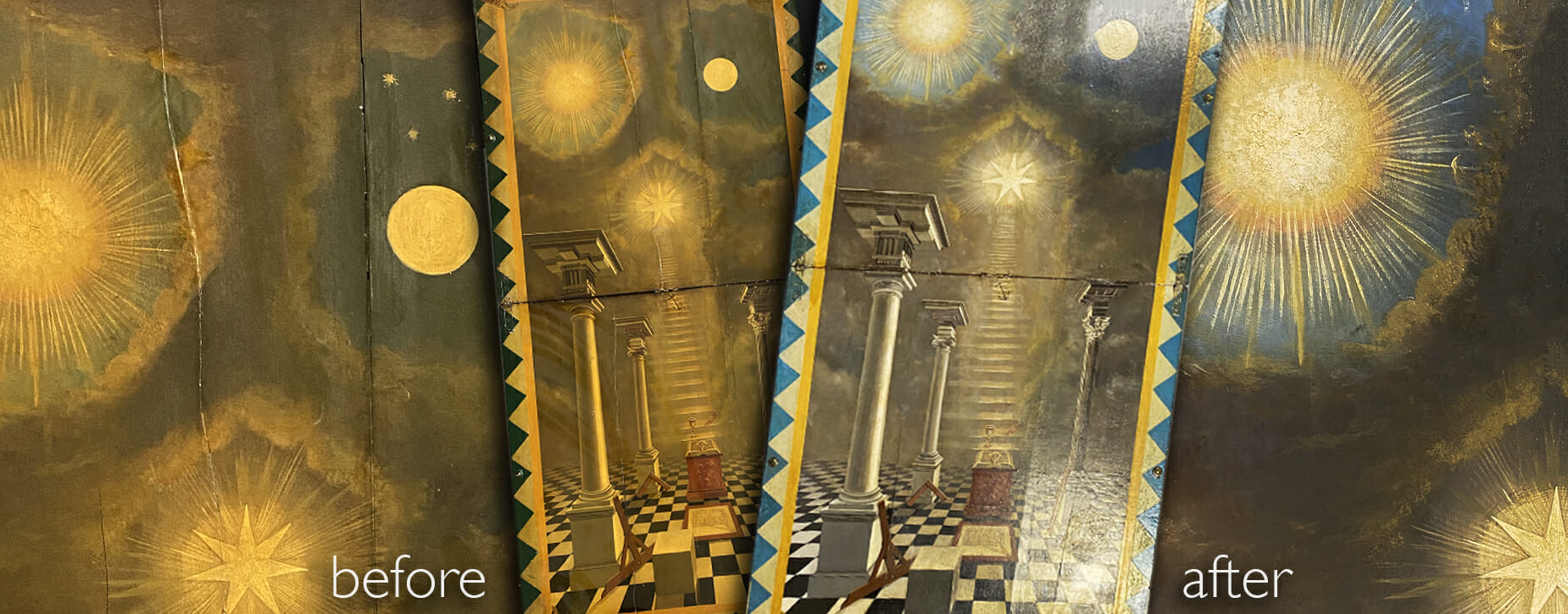 Above: an example of a Masonic tracing board which was restored by our team
Above: an example of a Masonic tracing board which was restored by our team Above: examples of Freemason art and decorative items, including an 18th century engraving of the Diploma for the Freemasons of Bordeaux after François Boucher, ceramic figurines by Meissen, Masonic Commemoration of the Centennial of Washington’s Death and a Masonic School Medal
Above: examples of Freemason art and decorative items, including an 18th century engraving of the Diploma for the Freemasons of Bordeaux after François Boucher, ceramic figurines by Meissen, Masonic Commemoration of the Centennial of Washington’s Death and a Masonic School Medal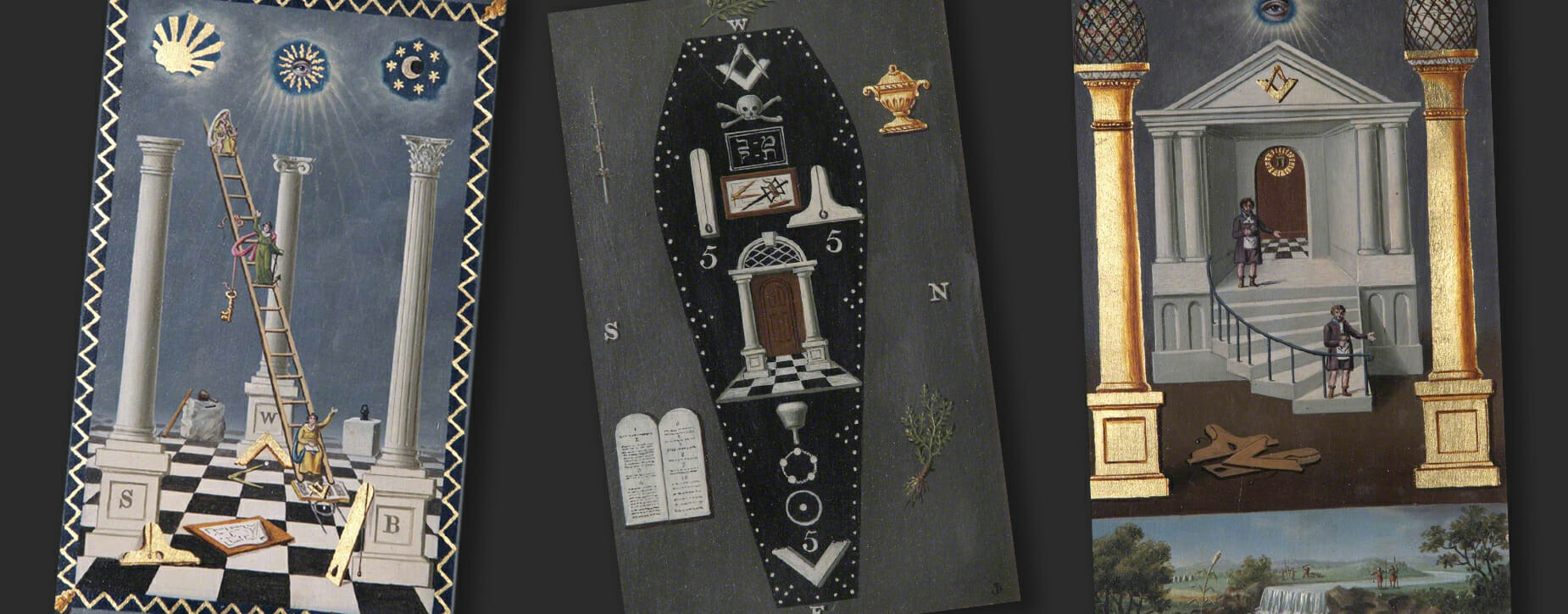 Above: examples of masonic tracing boards from the Museum of Freemasonry
Above: examples of masonic tracing boards from the Museum of Freemasonry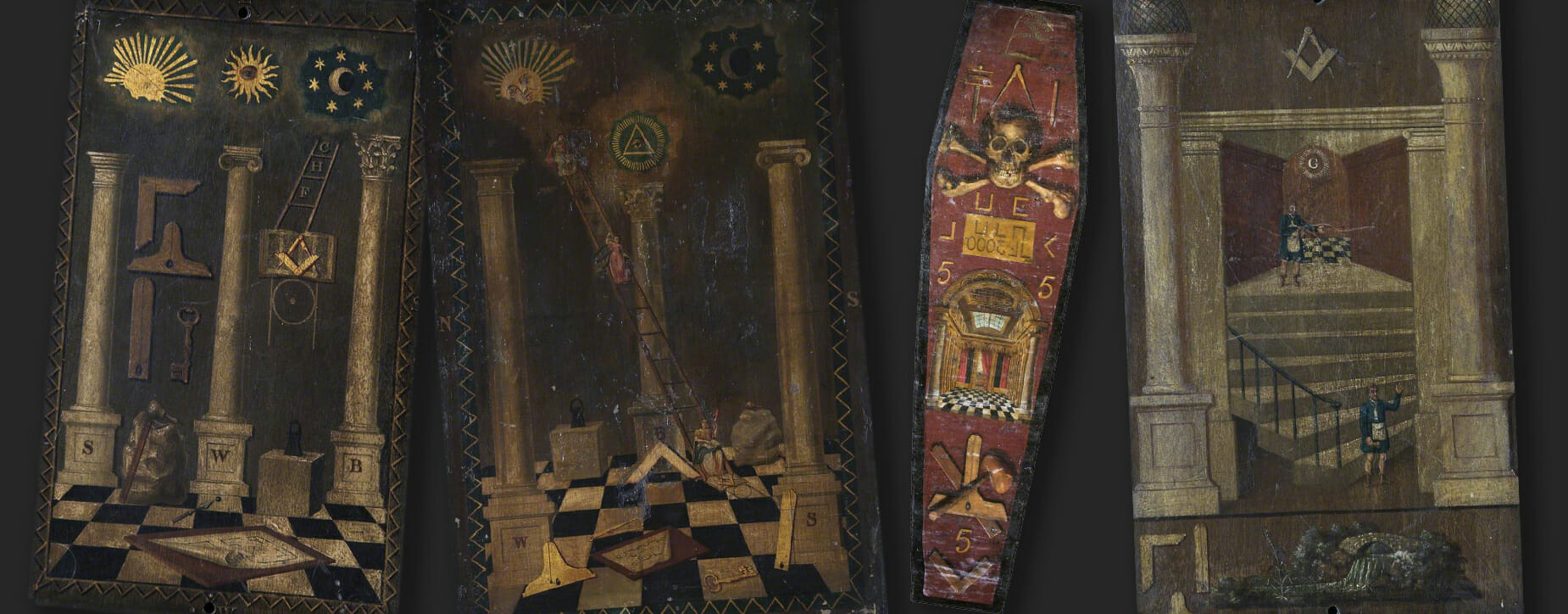 Above: examples of Masonic tracing boards with heavy discolouration to the surface due to contamination and old varnish
Above: examples of Masonic tracing boards with heavy discolouration to the surface due to contamination and old varnish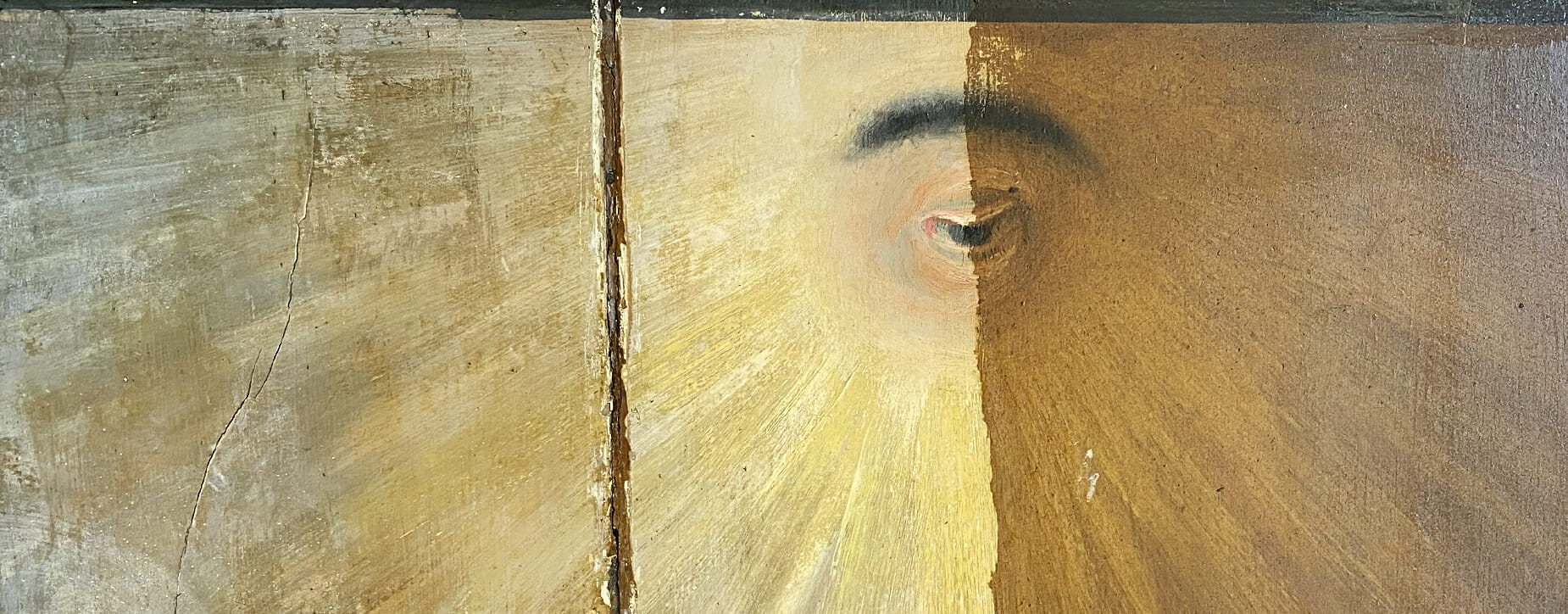 Above: a masonic tracing board part way through varnish removal by our conservators
Above: a masonic tracing board part way through varnish removal by our conservators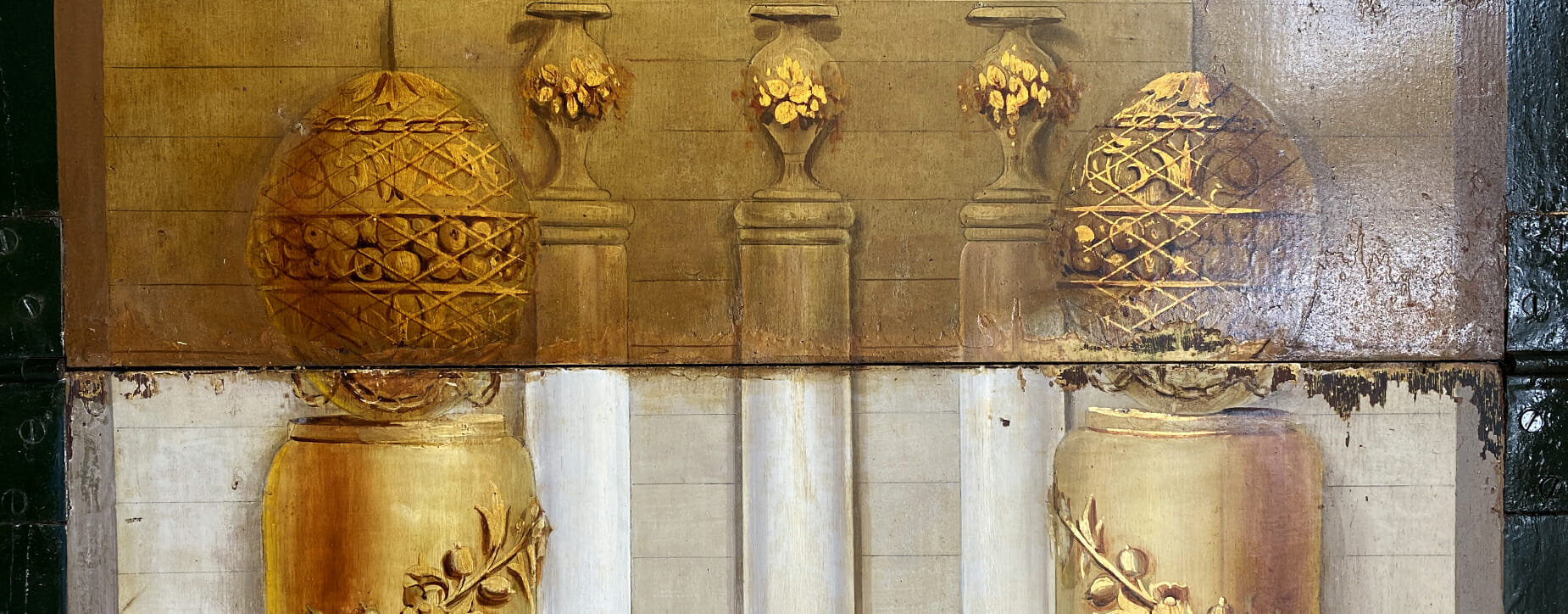 Above: a Masonic tracing board part way through being restored in our studio, the top half still shows old yellowing varnish, the bottom half has been cleaned by our conservators
Above: a Masonic tracing board part way through being restored in our studio, the top half still shows old yellowing varnish, the bottom half has been cleaned by our conservators  Above: discoloured, disturbed and flaking oil paintings can be professionally restored by our team – such as this portrait which was restored with funding from the Historic Houses Foundation
Above: discoloured, disturbed and flaking oil paintings can be professionally restored by our team – such as this portrait which was restored with funding from the Historic Houses Foundation 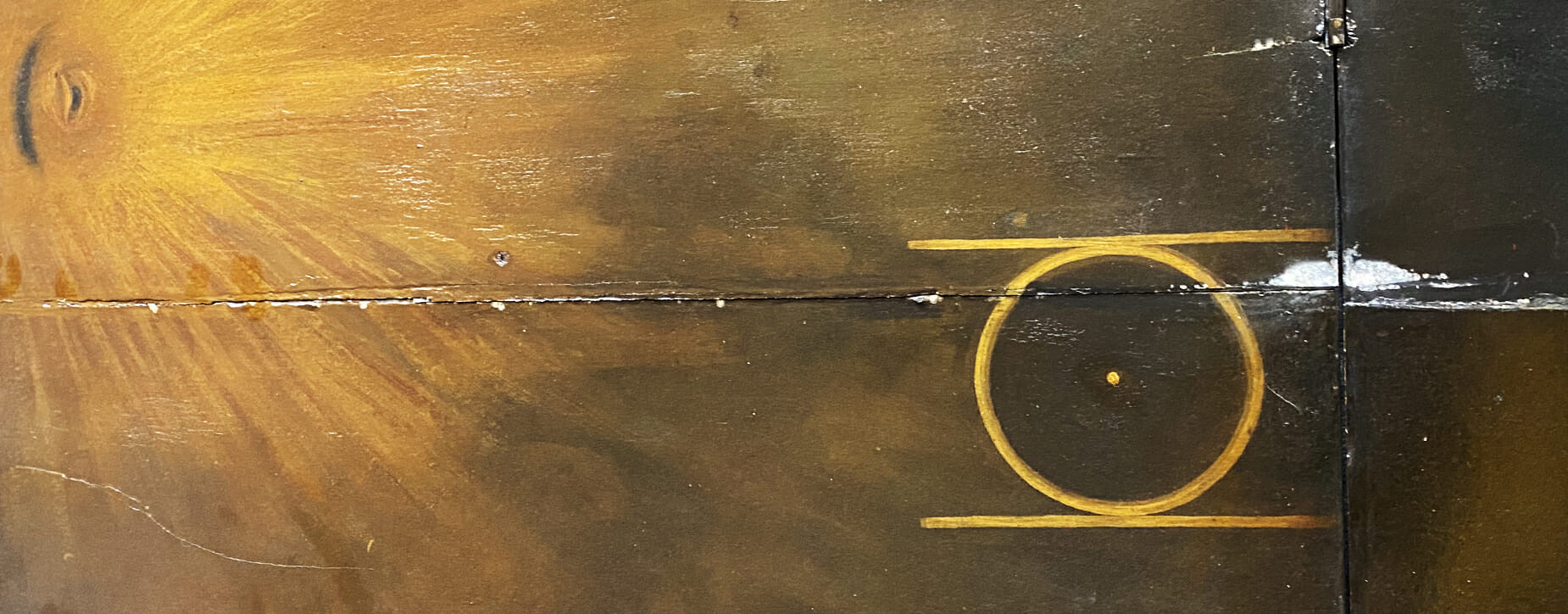 Above: a Masonic tracing board which has split along a panel, disturbing the artwork and encouraging paint loss
Above: a Masonic tracing board which has split along a panel, disturbing the artwork and encouraging paint loss Above: the back of a tracing board on panel might also face deterioration over time, such as this one which has areas of staining and splitting
Above: the back of a tracing board on panel might also face deterioration over time, such as this one which has areas of staining and splitting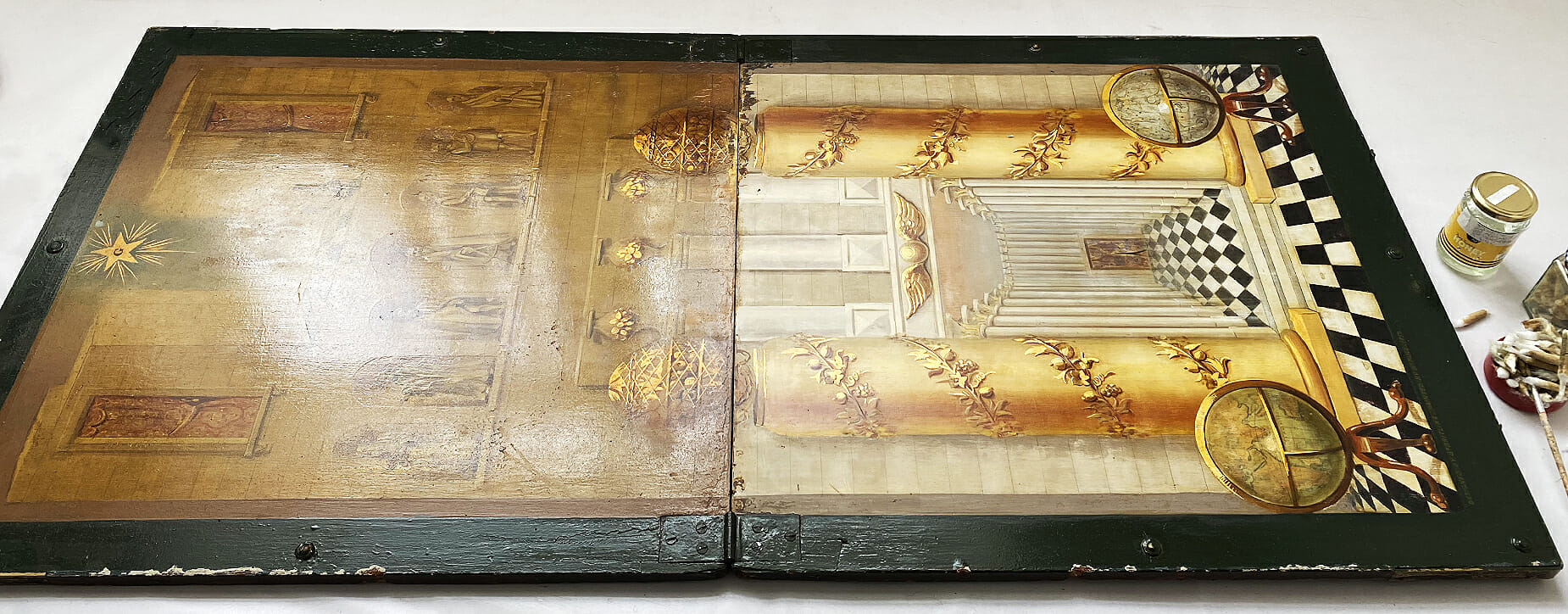 Above: the restoration of the Masonic tracing board in progress in our studio
Above: the restoration of the Masonic tracing board in progress in our studio 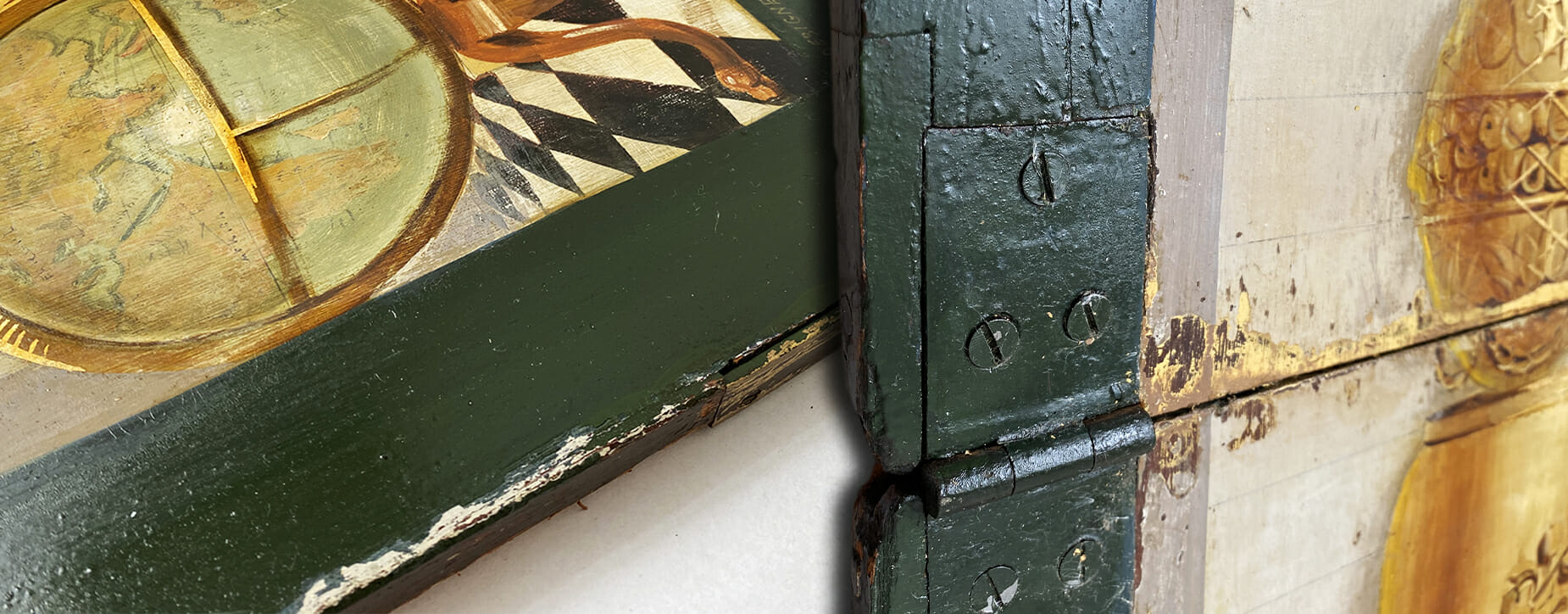 Above: the deterioration of the pigments as seen once the varnish is removed from the surface
Above: the deterioration of the pigments as seen once the varnish is removed from the surface Above: as well as tracing boards, our team can also restore metal items, ceramics and furniture such as these examples of Masonic art
Above: as well as tracing boards, our team can also restore metal items, ceramics and furniture such as these examples of Masonic art




